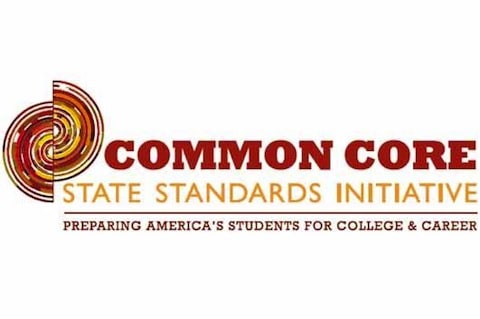Something In Common: The Common Core Standards

Robert Rothman wrote the first definitive book on new national standards last year:Something in Common: The Common Core Standards and the Next Chapter in American Education. It provides a history of what, with new online assessments, will prove to frame the next decade of American education.
If you have to pick one champion for the Common Core, you’d have to single out four-time North Carolina Governor Jim Hunt. Rothman chronicles two decades of Hunt’s leadership culminating with the critical role played by the Hunt Institute (where I was a founding director). Rothman also notes the pivotal role that two other former governors, Roy Romer on development and Bob Wise on adoption. President Bush also deserves credit for his advocacy of high standards.
If you have to pick one event that boosted adoption, you’d have to pick incorporation of the Common Core into Race to the Top grant program as part of the 2009 stimulus plan. That led to adoption by all but one of the 41 applicants. Rothman argues that grant-backed adoption by most states makes it more likely that the Core will influence classroom practice.
CCSSO , the state chiefs association, also gets credit, “The state schools chiefs, meanwhile grew increasingly interested in the idea of common standards after Gene Wilhoit came on board as executive director in November 2006. Rotherman also notes leadership contributions of NGA and Achieve.
Leaders were influenced by a 2007 paper written by David Coleman and Jason Zimba, Math and Science Standards that are Fewer, Clearer, and Higher to Raise Achievement At All Levels . Rothman notes, “Standards were from the outset intended to be parsimonious, coherent statement of what students need to know and be able to do at each grade level.”
Coleman, Zimba, and other standards writing leaders were driven by an interest in international benchmarking and college and career readiness. CCSSO and NGA created a validation committee chaired by college readiness expert David Conley, University of Oregon and Epic, which helped improve and protect the standards.
In some ways the Common Core looks like more of the same, but Rothman notes
that they “represent a substantial shift from many previous state standards.”
“By seeking more parsimony from the outset, the standards writers were forced
to make hard decisions about what was most important and what they could leave
out,” notes Rothman. “They were guided by the goal of ensuring that the standards
would be coherent and make sense to students, parents, and teachers, and that they
could serve as an effective guide to practice.”
On ways that Common Core is different and higher, Rothman points to Anchor
Standard 1 which states, “Read closely to determine what the text says explicitly an to make logical inferences from it; cite specific textual evidence when writing or speaking to support conclusions drawn from the text.”
The Standards also place a greater emphasis on expository texts with “reduced emphasis on narrative writing and a greater emphasis on informational and explanatory writing.”
Math standards (as noted in this review of a Bill Schmidt study) emphasize “focus and coherence.” Rather than courses, the “high school mathematics standards are organized by six conceptual categories: number and quality; algebra; functions; modeling; geometry; and statistics and probability.”
Adoption. In February 2010, before writers finished, Kentucky adopted the standards. Even more influential than early movers were the potential of a big Race to the Top grant. By the January 2010 deadline, forty states and the District of Columbia had applied and stated allegiance to the Common Core.
Rothman notes the importance of the web of Gates Foundation funded advocacy organizations as well as state adoption support efforts including curriculum alignment, professional development, and awareness development.
Incorporation into Race to the Top was important, but what will frame the next decade of American education is a new generation of Common Core assessments. In 2010, the Department made two grants totaling $330 million to two state testing consortia for development of Common Core assessments. Rothman notes that, “standards will not have an impact without related assessments.” The consortia plans represent “ambitious changes in the way student performance was measured” at a significant scale.
RiShawn Biddle’s post yesterday underscored the moral imperative of real college and career expectations for all students.
Impact. Rothman acknowledges the “thorny political issues” to come but confidently outlined likely impact including improved classroom practice. For example, “Student will also do a lot of writing that asks them to draw on evidence to make logical and reasoned arguments.” He notes likely state leadership changes and the challenge of ongoing governance and funding as potential obstacles to long-term impact.
Rothman concludes by noting the “burgeoning interest in innovation” but he names charter schools as an example. Perhaps this was written before what Michael Moe called the “near spontaneous explosion of entrepreneurial activity in education” was widely evident.
As he suggests, the $650 million i3 grant program solidified support for the Common Core. But he quoted some commentators that suggesting that standards would thwart innovation. The exact opposite is occurring.
What is proving to be even more significant than government investment is the explosion of private sector investment and innovation caused, in part, by the adoption of common standards. In June of 2010, I suggested that the Common Core is the iPhone for Education. In other words, I saw it as a common app platform that would focus and accelerate innovation. Conveniently timed with the historic shift to digital, the Common Core has launched an avalanche of innovation including adaptive learning platforms like i-Ready and a full Pearson digital Core-aligned curriculum like Huntsville launched this week. MasteryConnect and LearnZillion are some of the scrappy startups banking on Common Core. Some critics have suggested the requirement of big expenditures, but the Common Core Will Save Not Cost Billions. This August Robert Rothman published “Nine Ways the Common Core Will Change Classroom Practice” on the Harvard Education Letter.
Rothman provided a useful history of the Common Core but, stay tuned, we’re just getting started!
This blog first appeared on EdWeek.








0 Comments
Leave a Comment
Your email address will not be published. All fields are required.